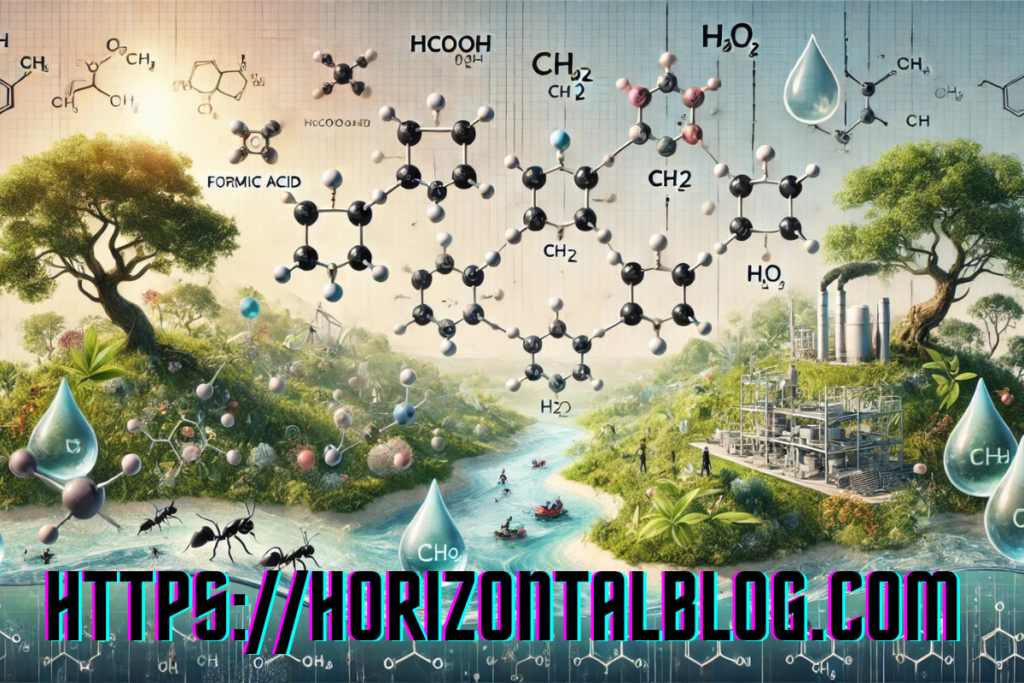Overview
Chemistry surrounds us in every aspect of life, from the air we breathe to the materials we use daily. Among the vast array of chemical compounds HCOOH (formic acid) CH2 (methene) and H2O (water) hold distinct importance. These compounds are not only integral to scientific studies but also have a direct impact on industries, ecosystems, and even our health. Let’s dive into the fascinating world of these three compounds to explore their properties, applications, and implications.
Understanding HCOOH (Formic Acid)
What is HCOOH?
Formic acid, denoted as HCOOH is the simplest carboxylic acid. Its molecular structure consists of a single carbon atom bonded to a hydroxyl group (-OH) and a carbonyl group (C=O). This makes it highly polar and reactive, with a pungent odor and the ability to donate protons readily.
Natural Occurrence of HCOOH
HCOOH is most commonly associated with ants and other stinging insects, where it serves as a defensive chemical. In addition, it is present in some plants and is produced during certain biological processes. Industrially, formic acid is synthesized via the oxidation of methanol or as a by-product in acetic acid production.
Applications of HCOOH
The applications of formic acid span various industries:
- Leather Industry: Used as a tanning agent.
- Agriculture: Added to animal feed as a preservative.
- Pharmaceuticals: Acts as a precursor in the synthesis of drugs.
Safety and Handling
Although useful, formic acid is corrosive and requires careful handling. Exposure can cause skin burns and respiratory irritation, making protective gear essential.
Exploring CH2
CH2 in Organic Chemistry
The CH2 group, also known as methene, is a fundamental building block in organic chemistry. This group appears in hydrocarbons and plays a significant role in forming chains and rings essential for various organic compounds.
Importance of CH2 in Chemical Reactions
CH2 is pivotal in numerous synthesis processes. For example, it contributes to the formation of polymers like polyethylene and serves as an intermediate in reactions that produce fuels, plastics, and more.
H2O – The Essence of Life
Composition and Properties of Water
Water’s chemical formula H2O represents two hydrogen atoms bonded to one oxygen atom. Its unique properties, such as its high heat capacity, surface tension, and ability to dissolve many substances, stem from hydrogen bonding and polarity.
Water’s Role in Nature and Life
Water is indispensable to life. It facilitates biochemical reactions, regulates temperature in organisms, and serves as a habitat for countless species.
Industrial Applications of Water
Beyond its natural role, water is vital in industries. It acts as a solvent for chemical processes, a coolant in power plants, and a medium in various energy production methods.
Interactions Between HCOOH CH2 and H2O
Chemical Reactions Involving HCOOH and H2O
When dissolved in water, formic acid ionizes, forming formate ions and hydrogen ions. This property makes it useful in reactions that require acidic conditions.
CH2’s Behavior in the Presence of H2O and HCOOH
In the presence of water, CH2 groups often participate in reactions like hydration or hydrolysis. When combined with formic acid, CH2 can form intermediates critical in synthetic pathways.
Environmental Implications
HCOOH in Nature
Formic acid plays a role in the natural carbon cycle but can also contribute to acidity in ecosystems when released in large quantities through industrial processes.
Water Pollution and CH2 Compounds
Hydrocarbons containing CH2 can contaminate water sources, posing risks to aquatic life. Advanced filtration and biodegradation methods are essential for mitigating this issue.
Future Prospects and Research
Innovations in Using HCOOH
Research into formic acid’s use in fuel cells and renewable energy storage highlights its potential as a green energy source.
Advances in Understanding CH2
Scientists are exploring CH2-based materials for their unique properties, such as flexibility and strength, in applications ranging from biotechnology to nanotechnology.
Conclusion
HCOOH CH2 and H2O are more than just chemical formulas—they are critical to science, industry, and life itself. Understanding their properties and interactions enables us to harness their potential while mitigating their risks, paving the way for a more sustainable future.
FAQs
1. What is the main use of HCOOH in industries?
Formic acid is primarily used in leather tanning and as a preservative in agriculture.
2. How does CH2 contribute to organic chemistry?
CH2 groups are crucial in forming hydrocarbons and serve as intermediates in many chemical reactions.
3. Why is water considered a universal solvent?
Water’s polarity and ability to form hydrogen bonds allow it to dissolve a wide range of substances.
4. Can HCOOH harm the environment?
In excess, formic acid can contribute to environmental acidity, affecting ecosystems.
5. What are the future applications of these compounds?
Potential applications include renewable energy technologies for HCOOH and advanced materials for CH2.



